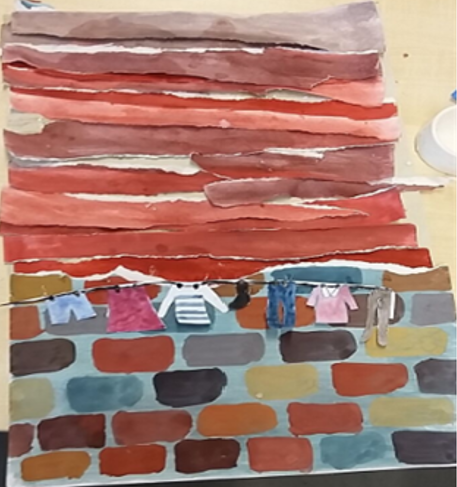This session provided a different way to learn about how children experience the arts as we were treated like primary 7 pupils in order to gain insight from their perspective. At KS2, according to McAuliffe, D (2007) children should be given more control over their own activities as their own creativity should guide their learning, however, the following activity does not allow this opportunity. We created continuous line drawings of a washing line before amalgamating this with a multi-coloured collage which we then ripped up and rearranged to create a sunset effect. My progress is displayed below:
This activity was useful in providing me with more teaching ideas. However I found this activity produced much too similar results from everyone and therefore takes away from the individualism and creativity of art. It had several boundaries and techniques to follow so children would not be free to explore their own ideas with this activity. However, more positively, many artistic techniques and shapes were used in this one activity including the continuous line drawing, painting different tones, creating a brick wall and making collages.
Additionally, it was extremely useful in the lecture to have the opportunity to view children’s artwork throughout the primary school years. This allowed me to see the quality of work that was produced when children were given enough time and resources.
Regarding the drama workshop, we further explored dramatic techniques such as: process drama, teacher in role, tableaux, improvisation, hot seating, flashback/flash forward, thought tracking, thought tunnel and forum theatre. Silverstein (2010) defines this process as “meeting evolving objectives” in which children gradually are given time and space to understand concepts before developing these further. Similarly in this session, we continued to increase our knowledge in dramatic techniques and move on to more challenging ones. Initially I was apprehensive to participate in the process drama and teacher in role as I felt intimidated in front of a large audience. However, as the session went on I began to relax and volunteered to role play Frankie Millar who was the main role in the improvisation, flashback/flash forward and thought tracking techniques.
Furthermore, this session made me realise how drama provides a lot of interdisciplinary learning opportunities through developing the imagination. This is important as “imaginative situations often put children in a position of confronting ethical principles, examining their personal values and moral codes, and can help them learn to tolerate ambiguity and uncertainty” (Grainger, 2003, in Jones and Wyse, 2013, p.89) Through “The Lonely Dragon”, it provided opportunities for cross-curricular approaches such as interviewing the dragon to find out why it is feeling lonely during teacher in role in drama and writing a letter to invite the dragon to a party in English lessons or creating party decorations in an art class. I think “The Lonely Dragon” would be very fun and engaging for children as it provides so many pathways to go from as well as providing opportunities for both large and small role play parts so that all children are included.
I thought forum theatre was particularly interesting as this was a new concept to me and may engage children more as they have the opportunity to critique and improve their peers’ performance by providing suggestions. It is also a great way for children to be reflective on their own and others’ performances and for audience interaction so as children are actively involved.
Following from this session, it is important that I continue to discover more techniques and research more art ideas to refrain from all children creating similar pieces of artwork. This will in turn promote maximum creativity skills as children would be free to express themselves through their creations with minimum boundaries. For drama, it is required that I continue to increasingly participate so as to increase my confidence especially if I was to do teacher in role as that requires a lot of improvisation. I think main challenges of drama are making sure everyone participates, especially those less extrovert and ensuring they gain the same experiences and outcomes as other children.
McAuliffe, D (2007) Foundation and Primary Settings. In: Mark O’Hara (eds) Teaching Art and Design 3 – 11 London: Continuum.
Silverstein, L and Layne, S (2010) Defining Arts Integration The John F. Kennedy Centre for the Performing Arts.



